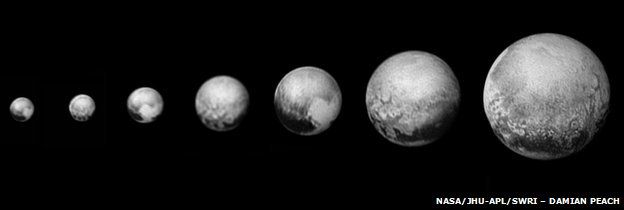-
13 July 2015
- From the section Science & Environment

Pluto has just been found to be ever so slightly bigger than we thought, having a diameter of 2,370km.
The measurement was made by the New Horizons probe which is just about to flyby the dwarf world.
The result means it is confirmed as the largest object yet detected in the outer zone of the Solar System known as the Kuiper Belt.
Nasa’s probe is set to return a treasure trove of images and data when it sweeps past Pluto.
It is likely that in that data will be information that can further refine the object’s size.
The new measurement has a number of implications. The first is that it makes Pluto slightly less dense than we thought, meaning the fraction of ice in its interior is probably higher than we had recognised.
The measurement also changes some of the expected properties of the atmosphere, given that the sphere it envelops is now considered to be larger. For modellers, it suggests the troposphere, the lowest layer, is a bit shallower.
But perhaps the main consequence from this result is what it does for Pluto fans, because it finally settles the debate over which is the bigger – Pluto or Eris?
The latter’s discovery in 2005, with its comparable girth, were partly responsible for getting Pluto demoted from full planet status in 2006. However, this new result indicates that Pluto really does have the upper-hand, if only by about 30km in terms of diameter.
One of the reasons for past uncertainty has been the presence of that atmosphere at Pluto – something Eris does not share in such abundance. So, while scientists could be much more sure of Eris, Pluto’s diameter has jumped about, depending on the assumptions made.
But New Horizons’ fast-approaching cameras have put the arguments to bed.
“Before New Horizons, we had a range from 1,150km in radius, up to a little bit north of 1,200km. And what we found is that Pluto is almost at the top of that range,” said Prof Alan Stern, the probe’s principal investigator.
The probe will pass just 12,500km above the dwarf planet on Tuesday at 11:50 GMT (12:50 BST; 07:50 EDT).
The spacecraft will be out of radio contact with Earth when that happens.
All mission controllers can do is wait for the signal from New Horizons confirming it has survived the close encounter and has all the data it was commanded to gather. This message should come through at 00:53 GMT Wednesday (01:53 BST; 20:53 EDT Tuesday).
Glen Fountain, the New Horizons project manager, has told his team to stay focused but to try also to soak up some of the atmosphere.
“I’ve told the team they really need to be living the time,” he said in a briefing to reporters.
“I mean, how often do you get a chance like this, to realise that you are participating in something much larger than yourself?”
New Horizons continues to downlink data on approach to Pluto. Selected pictures are being processed for public release.
Each new release brings surface features into sharper focus.
The latest postings include views of Pluto’s major moon, Charon.
Seen clearly in these new pictures are huge chasms and craters, as well as the moon’s so-far-unexplained dark pole.
Scientists say this has been one of the major surprises of the encounter so far, as has the very contrasting appearance of Charon and Pluto.
The BBC will be screening a special Sky At Night programme called Pluto Revealed on Monday 20 July, which will recap all the big moments from the New Horizons flyby.
Follow Jonathan on Twitter.


